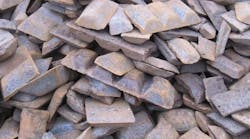Two new techniques developed by Australia’s Commonwealth Scientific and Industrial Research Organisation are described as more environmentally friendly production steps that will make conventional diecastings stronger.
Both systems — a gating system and a runner system — are suitable for use with standard aluminum and magnesium alloys. They produce high-integrity castings with fine-grained microstructures and low porosity by improving the feed of molten metal into the mold. “This is accomplished by influencing the flow behavior of the molten metal, the fill pattern of the die, and subsequent solidification,” according to Dr. Robert O’Donnell, leader of CSIRO’s team of metallurgists and casting engineers. “Our researchers realized that by changing the way in which molten metal is delivered to the die, we could take advantage of the high pressure inherent in the process to make castings with finer microstructure and lower porosity.”
CSIRO is Australia’s national science agency, and it oversees one of the world’s largest and most diverse series of research programs. These R&D efforts cover industry, agriculture, earth science, materials science, energy, and 10 other disciplines. The two new diecasting developments are available for licensing by a commercial partner.
The researchers achieved higher-quality castings by changing the architecture of the runners and the gate. “Our improved melt delivery systems are cost-effective, can be used with existing casting machines, and can significantly reduces the mass of the metal runner, wasting less metal,” added O’Donnell. “They represent new “green” diecasting technologies, which are low-energy and highly effective.”
The dynamic gating system, or DGS, incorporates a gate capable of changing its size in response to the pressure of the melt during filling. Gases trapped as molten metal enters the die cavity will cause porosity in the finished structure. Together with voids created during solidification, this reduces the quality of the casting.
O’Donnell says the new feed system goes against conventional design theory because it includes a constriction in the runner with a smaller cross-sectional area than the gate. “The metal accelerates through this constriction, undergoing extensive shear during its passage. This results in the shearing of cold flakes, gas bubbles, pre-solidified grains, and any other entrained entities into much finer fragments. The metal thus flows into the cavity better, and produces castings with finer microstructure and greater integrity,” he says.
According to O’Donnell, the DGS approach eliminates anywhere from a few ounces of metal in small castings to three or more pounds in large castings by using a smaller runner. “Some castings have runners that represent the thickest — and therefore the slowest cooling — section of the shot,” he says.
“Where the solidification of the runner dictates cycle time, smaller runner masses will reduce cycle time,” O’Donnell continues. He indicates that DGS produces parts that are stronger than parts produced by high-pressure diecasting, and some products are heat-treatable, so the new runner technique permits the redesign of components for thinner sections, which will reduce part weight and further reduce metal usage.
X-ray analysis of test castings showed significant improvement in density in both thicker and thinner areas of the casting when the DGS was used.
The second system — the ATM technology — uses a revolutionary melt delivery system for high-pressure diecasting, which costs less to operate than conventional HPDC. “ATM conditions the melt prior to filling the cavity so that the melt enters the die in a less vicous, “runnier” state,” said O’Donnell. “As a result, melt flow is improved and separate melt fronts fuse together better when they meet within the casting.”









